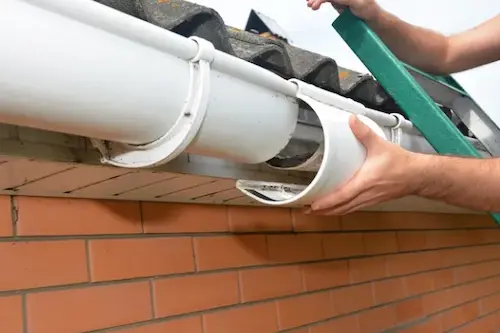Choosing the best gutters for your home: Downspout and Gutter Sizes (2024 Guide)

We understand gutters’ vital role in protecting your home from water damage. Selecting the proper downspout and gutter sizes is crucial to ensure efficient water drainage and avoid potential issues such as foundation damage or landscaping erosion.
This comprehensive guide will walk you through the factors to consider when choosing the best gutters for your home, focusing on downspout and gutter sizes in 2024.
1. Understanding Gutter and Downspout Sizes
Before delving into the specifics, it’s essential to understand the function of gutters and downspouts. Gutters collect rainwater from your roof, while downspouts direct this water away from your home’s foundation. The size of gutters and downspouts directly impacts their effectiveness in managing water flow.
2. Key Factors Influencing Gutter and Downspout Sizes
1. Roof Size and Pitch: The size of your roof plays a significant role in determining the appropriate downspout and gutter sizes. A larger roof area or a steeper pitch will generate more runoff, requiring larger gutters and downspouts to handle the increased volume of water. We assess your roof’s dimensions to recommend the right size for your gutters and downspouts.
2. Rainfall Intensity: Different regions experience varying levels of rainfall. Areas with heavy rainfall require larger downspouts and gutter sizes to manage the increased volume of water efficiently. Our team considers local weather patterns and rainfall data when recommending gutter sizes that will perform optimally in your area.
3. Gutter Material: The material of your gutters can influence the size selection. For instance, aluminum and copper gutters are available in various sizes and can be customized to fit your home’s requirements. We offer a range of materials, each with its own set of advantages and suitability for different downspout and gutter sizes.
4. Gutter Profile: Gutters come in different profiles, such as K-style and half-round. Each profile has its sizing options and capacities. We guide you in selecting the most suitable profile for your home, ensuring that the downspout and gutter sizes match your needs.
5. Downspout Placement: Proper placement of downspouts is as important as their size. Downspouts should be evenly distributed along the gutters to ensure efficient water flow. The size of the downspout must match the gutter size to prevent overflow and water damage. Michaels Sheet Metal experts evaluate your home’s layout to determine the optimal placement and length for your downspouts.
3. Calculating the Right Size for Your Gutters and Downspouts
Determining the correct downspout and gutter sizes involves calculations based on your roof’s dimensions, rainfall intensity, and gutter profile. Here’s a step-by-step approach we follow at Michaels Sheet Metal:
1. Measure the Roof Area: Calculate the total roof area by multiplying each roof section’s length and width. This gives us an estimate of how much water your gutters need to handle.
2. Assess Rainfall Data: Obtain local rainfall data to understand the volume of water your gutters must manage. This data helps select the appropriate downspout and gutter sizes to prevent overflow during heavy rain.
3. Choose Gutter Profile and Material: Based on the roof area and rainfall data, choose a gutter profile and material that can accommodate the required water volume. Michaels Sheet Metal offers various profiles and materials, each suited for different applications.
Get Started
For any questions or concerns, get in touch with our knowledgeable staff today. We would be glad to assist you!
Contact Us Today4. Determine Downspout Size and Placement: Calculate the appropriate downspout size based on the gutter size and roof area. Ensure that downspouts are placed regularly to handle the water flow efficiently.
4. Common Gutter and Downspout Sizes
Here’s a quick overview of the common downspout and gutter sizes available in 2024:
1. 5-Inch Gutters: Suitable for average-sized homes with moderate rainfall. Ideal for K-style profiles, these gutters can handle a reasonable amount of water and are commonly used in residential settings.
2. 6-Inch Gutters: These are recommended for larger homes or areas with heavy rainfall. They offer increased capacity and can handle more water than 5-inch gutters.
3. 2×3-Inch Downspouts: Typically paired with 5-inch gutters, these downspouts are sufficient for homes with average water runoff.
4. 3×4-Inch Downspouts: Designed for 6-inch gutters, these downspouts handle higher water volumes and are ideal for homes in regions with heavy rain.
5. Maintenance Tips for Gutters and Downspouts
Choosing the proper downspout and gutter sizes is only the first step. Regular maintenance is essential to keep your gutters and downspouts functioning correctly. Here are some maintenance tips from Michaels Sheet Metal:
1. Clean Gutters Regularly: Remove debris such as leaves and twigs to prevent clogs that obstruct water flow. Regular cleaning also helps maintain the efficiency of your chosen downspout and gutter sizes.
2. Inspect for Leaks: Check your gutters and downspouts for leaks or signs of damage. Prompt repairs prevent water damage and ensure the longevity of your gutters.
3. Ensure Proper Downspout Placement: Verify that downspouts are directed away from your home’s foundation. Proper placement prevents water pooling around the foundation and reduces erosion risk.
Selecting the right downspout and gutter sizes is crucial for maintaining your home’s integrity. We are committed to helping you choose the best gutters and downspouts for your specific needs. By considering roof size, rainfall intensity, and gutter material, you can ensure effective water management and protect your home from potential water damage. For personalized recommendations and expert installation, Contact Us today.